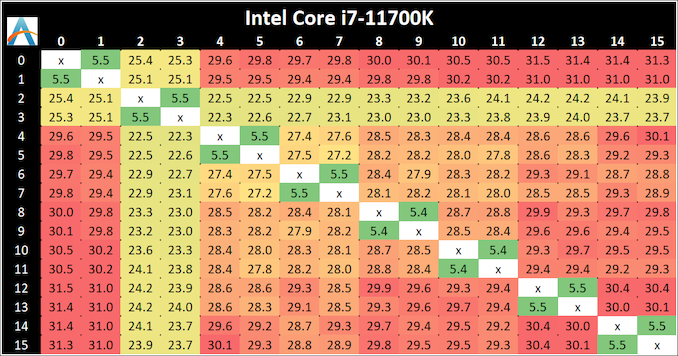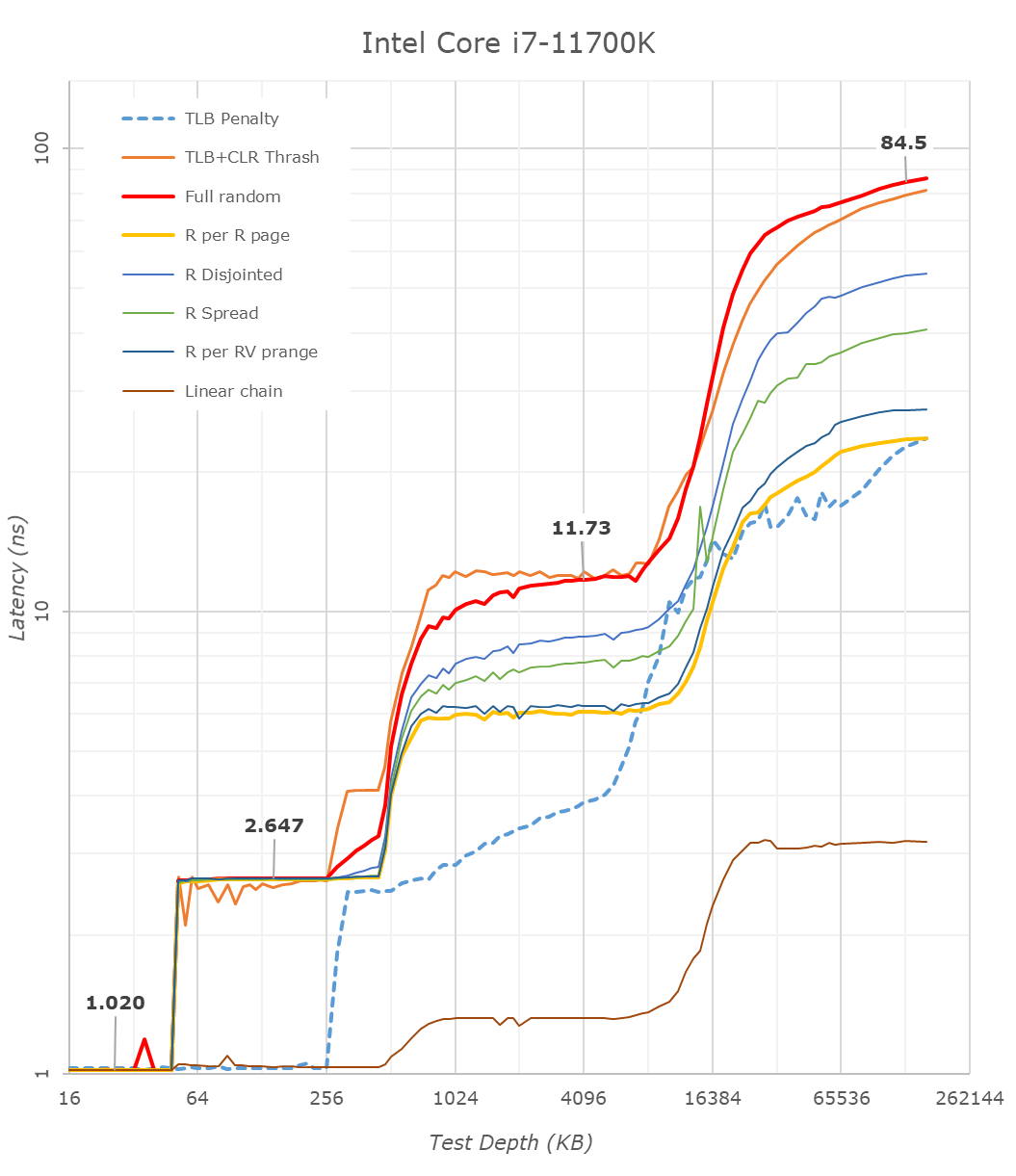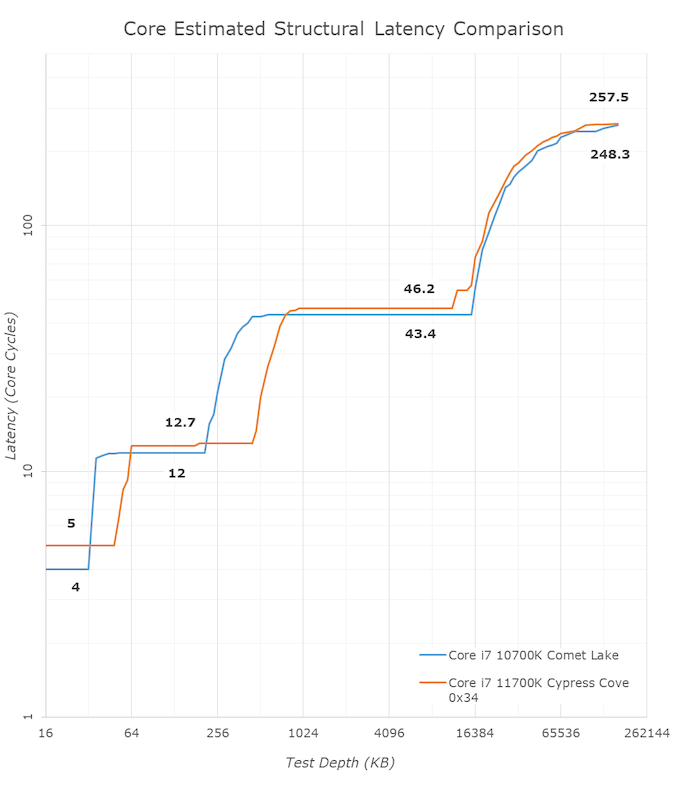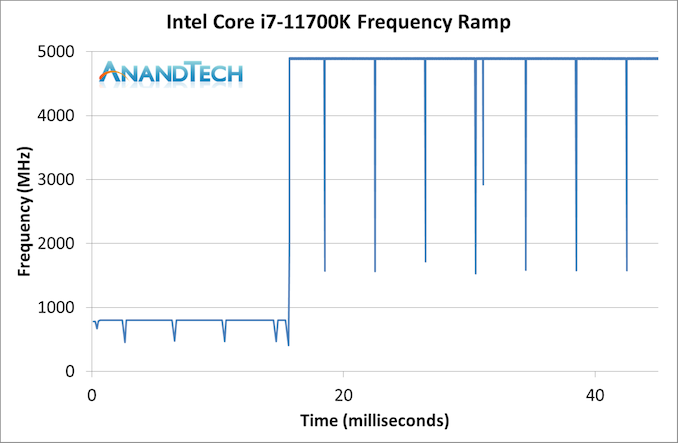Intel Core i7-11700K Review: Blasting Off with Rocket Lake
by Dr. Ian Cutress on March 5, 2021 4:30 PM EST- Posted in
- CPUs
- Intel
- 14nm
- Xe-LP
- Rocket Lake
- Cypress Cove
- i7-11700K
CPU Tests: Microbenchmarks
Core-to-Core Latency
As the core count of modern CPUs is growing, we are reaching a time when the time to access each core from a different core is no longer a constant. Even before the advent of heterogeneous SoC designs, processors built on large rings or meshes can have different latencies to access the nearest core compared to the furthest core. This rings true especially in multi-socket server environments.
But modern CPUs, even desktop and consumer CPUs, can have variable access latency to get to another core. For example, in the first generation Threadripper CPUs, we had four chips on the package, each with 8 threads, and each with a different core-to-core latency depending on if it was on-die or off-die. This gets more complex with products like Lakefield, which has two different communication buses depending on which core is talking to which.
If you are a regular reader of AnandTech’s CPU reviews, you will recognize our Core-to-Core latency test. It’s a great way to show exactly how groups of cores are laid out on the silicon. This is a custom in-house test built by Andrei, and we know there are competing tests out there, but we feel ours is the most accurate to how quick an access between two cores can happen.
The core-to-core numbers are interesting, being worse (higher) than the previous generation across the board. Here we are seeing, mostly, 28-30 nanoseconds, compared to 18-24 nanoseconds with the 10700K. This is part of the L3 latency regression, as shown in our next tests.
One pair of threads here are very fast to access all cores, some 5 ns faster than any others, which again makes the layout more puzzling.
Update 1: With microcode 0x34, we saw no update to the core-to-core latencies.
Cache-to-DRAM Latency
This is another in-house test built by Andrei, which showcases the access latency at all the points in the cache hierarchy for a single core. We start at 2 KiB, and probe the latency all the way through to 256 MB, which for most CPUs sits inside the DRAM (before you start saying 64-core TR has 256 MB of L3, it’s only 16 MB per core, so at 20 MB you are in DRAM).
Part of this test helps us understand the range of latencies for accessing a given level of cache, but also the transition between the cache levels gives insight into how different parts of the cache microarchitecture work, such as TLBs. As CPU microarchitects look at interesting and novel ways to design caches upon caches inside caches, this basic test proves to be very valuable.
Looking at the rough graph of the 11700K and the general boundaries of the cache hierarchies, we again see the changes of the microarchitecture that had first debuted in Intel’s Sunny Cove cores, such as the move from an L1D cache from 32KB to 48KB, as well as the doubling of the L2 cache from 256KB to 512KB.
The L3 cache on these parts look to be unchanged from a capacity perspective, featuring the same 16MB which is shared amongst the 8 cores of the chip.
On the DRAM side of things, we’re not seeing much change, albeit there is a small 2.1ns generational regression at the full random 128MB measurement point. We’re using identical RAM sticks at the same timings between the measurements here.
It’s to be noted that these slight regressions are also found across the cache hierarchies, with the new CPU, although it’s clocked slightly higher here, shows worse absolute latency than its predecessor, it’s also to be noted that AMD’s newest Zen3 based designs showcase also lower latency across the board.
With the new graph of the Core i7-11700K with microcode 0x34, the same cache structures are observed, however we are seeing better performance with L3.
The L1 cache structure is the same, and the L2 is of a similar latency. In our previous test, the L3 latency was 50.9 cycles, but with the new microcode is now at 45.1 cycles, and is now more in line with the L3 cache on Comet Lake.
Out at DRAM, our 128 MB point reduced from 82.4 nanoseconds to 72.8 nanoseconds, which is a 12% reduction, but not the +40% reduction that other media outlets are reporting as we feel our tools are more accurate. Similarly, for DRAM bandwidth, we are seeing a +12% memory bandwidth increase between 0x2C and 0x34, not the +50% bandwidth others are claiming. (BIOS 0x1B however, was significantly lower than this, resulting in a +50% bandwidth increase from 0x1B to 0x34.)
In the previous edition of our article, we questioned the previous L3 cycle being a larger than estimated regression. With the updated microcode, the smaller difference is still a regression, but more in line with our expectations. We are waiting to hear back from Intel what differences in the microcode encouraged this change.
Frequency Ramping
Both AMD and Intel over the past few years have introduced features to their processors that speed up the time from when a CPU moves from idle into a high powered state. The effect of this means that users can get peak performance quicker, but the biggest knock-on effect for this is with battery life in mobile devices, especially if a system can turbo up quick and turbo down quick, ensuring that it stays in the lowest and most efficient power state for as long as possible.
Intel’s technology is called SpeedShift, although SpeedShift was not enabled until Skylake.
One of the issues though with this technology is that sometimes the adjustments in frequency can be so fast, software cannot detect them. If the frequency is changing on the order of microseconds, but your software is only probing frequency in milliseconds (or seconds), then quick changes will be missed. Not only that, as an observer probing the frequency, you could be affecting the actual turbo performance. When the CPU is changing frequency, it essentially has to pause all compute while it aligns the frequency rate of the whole core.
We wrote an extensive review analysis piece on this, called ‘Reaching for Turbo: Aligning Perception with AMD’s Frequency Metrics’, due to an issue where users were not observing the peak turbo speeds for AMD’s processors.
We got around the issue by making the frequency probing the workload causing the turbo. The software is able to detect frequency adjustments on a microsecond scale, so we can see how well a system can get to those boost frequencies. Our Frequency Ramp tool has already been in use in a number of reviews.
Our ramp test shows a jump straight from 800 MHz up to 4900 MHz in around 17 milliseconds, or a frame at 60 Hz.














541 Comments
View All Comments
jacropolis - Sunday, March 7, 2021 - link
The 10700K is regularly $279 at Micro Center and isn't a bad buy for that price at all.Jadi - Sunday, March 7, 2021 - link
350 Dollar you want a 10700k and comparing it with a 5800X?Why?
The 5800X don t have a gpu, and the 10700ks was under 320 euros allways!
Now the 10700K not KS cost 316 euros!
Hot a 14nm Chip this is the advantage its only 60 c and a 5800X comes easy over 85 c and more.
More expansiv a 5800X cost 440 euros! A 5600X cost 350 euros, more then the 10700k!
Slower its a K CPU and can boost it up. When you OC the 5800X you have less fps.
Why you think it needs more power? Becouse the 40 sec boost? That is all and under AVX512 is it the only cpu that have it.
Games and other stuff its the same power, And 5800X dosen t stop at 105 Watt it goes like 118 watts. Thats are very close too 125 watts and more is only a limit time!
Spunjji - Monday, March 8, 2021 - link
@Jadi - that last bit of your post makes no sense. The 10700K and 11700K objectively require more power than the 5800X to do the same amount of work; the 5800X only hits 118 Watts under the same conditions that the other two approach 200 Watts. If you're comparing power draw during gaming, the 5800X uses less power than those two - roughly 25W less than the 10700K.Comparing temperatures is daft too. 85 degrees is way under the CPU's junction temperature, so it's not a problem to runa cPU at that temp - and it's objectively easier to keep an AMD CPU at that temperature than to keep an Intel chip at 60 degrees, because your cooler isn't dissipating as much heat.
TrueJessNarmo - Tuesday, March 9, 2021 - link
10700k is $320 on amazon and 9900k is $250 at microcenter.At this point 5900x is best for serious users and 9900k/10700k is for gamers. 5600x and 5800x are overpriced for what it is, but 5900x is a sweet deal at $550
rfxcasey - Wednesday, March 17, 2021 - link
I got my 10700K for 330 dollars new, I've seen them go for as low as 300.Makste - Saturday, March 6, 2021 - link
With gaming it's not the power consumption that's the problem here, it is the gaming performance in these benchmarks against comet lake obviously due to a higher latency.Zen 3's efforts have been put into perspective here, those engineers did quite a commendable job.
Bfree4me - Sunday, March 7, 2021 - link
Agreed! The Zen architecture is top shelf. But it took far too long. My last AMD Cpu was an Athlon 1800 because at that time AMD was the value leader and Intel was the performance king for a price. At the time came where I needed performance over value.So I have been Intel since then. Time to start looking towards Zen 🤔
Timoo - Monday, March 8, 2021 - link
If I may be so free: "Took way too long": I agree.I just keep in mind that it took them way too long, because Intel managed to create some very shady deals with retailers, effectively pushing AMD out of the market and to the brink of bankruptcy. So, for years AMD has been struggling to stay alive.
Agreed, buying ATi didn't help either. But without those shady deals they might have pulled it off. From 2006 to -say- 2015 AMD was only struggling to stay alive. I believe they had some huge cash injection at the time, together with getting one of the best CPU designers in the world (what's his name?) back in the house.
So, in my opinion, AMD is forgiven for their 10-year "heart-attack".
GeoffreyA - Monday, March 8, 2021 - link
I also believe it was because the K10, or Phenom, while being faster than the Athlon 64, was not aggressive enough. It had already been designed before Core 2 Duo came out, and by then, Intel was ahead of them. Who knows, they might have narrowed the gap if they had persisted with the K10 design, widening everything till it matched/surpassed Nehalem, but they shot too far, going for Bulldozer, which was supposed to turn the tables round but sank them further in the ditch.TheinsanegamerN - Monday, March 8, 2021 - link
And yet AMD was having trouble supplying enough chips to the limited market they did have. Much like today. OEMs are not going to sign up with a company that cant consistently supply CPUs.Dont forget the billiosn they poured into making GF and pissing off TSMC in the process.